Sometimes having zero isn't a good thing as it implies nothing, however in some cases having a good zero means everything and is what people actively seek! I know, that sounds confusing right? I refer to obtaining a good zero on a rifle scope.
But what is zero?
Gaining a zero, when in reference to a rifle scope, refers to the process of aligning the sights with the rifle's barrel to allow the shooter to accurately and repeatedly, drop projectiles onto targets down range.
As a long range shooter myself I rely heavily on telescopic sights, generally called scopes, rather than iron sights [open sights], which cannot perform as effectively as a scope at long range. The process of alignment is referred to as zeroing or sighting the rifle generally and there's a few different ways to do it but I'll not go into that today though, rather I want to introduce the systems used to align the scope.
There's two systems called Minute of Angle referred to hereafter as MOA and Milliradian referred to from now on as MRAD.
It's interesting to note that whilst MRAD was developed then used for military use in artillery, MOA was developed around astronomy. Both use segments of arc to determine a change in trajectory over a set distance though and are perfect for determining field firing solutions for firearms. I've worked with both in my shooting over the years although work totally in MRAD these days. More about that later.
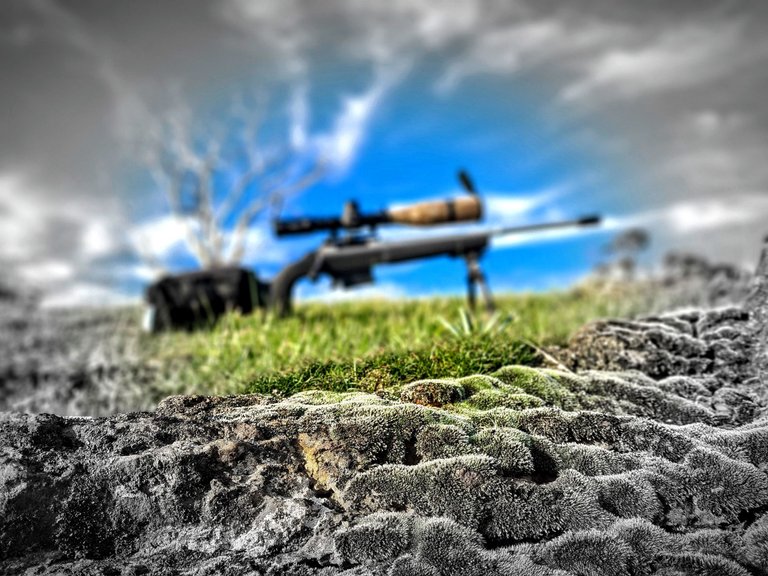
MOA - Minute of Angle
One MOA is a measurement equal to 1 inch at 100 yards or so close to it the difference doesn't matter. At 200 yards it's 2 inches, 300 yards is 3 inches and so on. This refers to the deviation of the trajectory. If I was to shoot at a target 300 yards away and the scope was not zeroed, let's call it 3 MOA out, then the projectile [bullet] would miss the point of aim [POA] by 3 inches. At 500 yards it would miss by 5 inches and so on. Easy right?
An MOA scope, a scope that uses MOA as a measurement for elevation and windage adjustments, [usually] uses 0.25 [1/4"] increments - So, 0.25 inches at 100 yards, 0.5 inches at 200 yards and so on. Still easy right?
One simply makes the required elevation and windage calculations based on range, wind, slope-angle, light aberration, Coriolis, speed and direction of target if moving, altitude, temperature and humidity usually combined as density altitude and a few other factors and then dials in the required MOA to the elevation and windage turrets and proceeds to do all the other things required prior to sending it down range to the target.
MOA example to gain a zero
Assuming you wanted to zero your rifle at 200 yards but it had a drop of 1.5 inches [shooting 1.5 inches low] you would need to move the scope up by .75 MOA, so three increments, called clicks because the scope turret clicks when each increment is dialled in. Click, click click up and the crosshairs will be shooting at the point of aim at that 200 yard range. Keep in mind it's an angular measurement so at closer range, or farther, it will be different. At 200 yards though, the scope/rifle will be considered zeroed - Good to go.
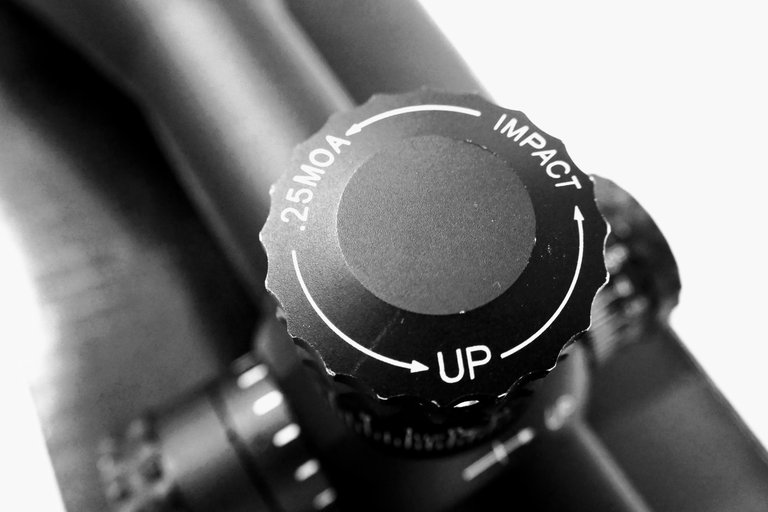
But there's more - True MOA
The system of MOA is old, like 3rd millennium BC old! The Sumerians first divided a circle into 360 degrees and the Babylonians took it a step further by taking each degree and dividing it by 60 minutes of arc totaling 21,600 minutes of arc in a full circle. [60 x 360]. It's easy to see it as an Imperial system when shooting but it is not.
To place rounds on targets at greater distance a shooter simply can't round things out and so true MOA is used. Calculating shot adjustments using the 1 inch at 100 yards when one is shooting at 1000 yards isn't good enough - The small variations are exacerbated at greater distance you see and could culminate in an ineffective shot.
Geometry does the work here; The circumference of a circle can be determined by the distance [or radius] from shooter to target. Assuming 100 yards range and applying the 2 π r formula we see that 2 x 3.14 x 100 = 628 yards. With 36 inches to each yard the circle's circumference is 22,608. Divide that by the number of MOA in a circle, [21,600 remember?] the quotient becomes 1.047" as the actual deviation of 1 MOA at 100 yards, not 1 inch.
Making it practical
Long range shooters use true MOA but could you imagine having to do those calculations in a pressured situation? It wouldn't work so well when seconds count. That's why we use ballistics solvers that do the work for the operator.
I use StrelokPro [available on the AppStore and PlayStore] although there are many others. This software combines all the information and spits it out like in the table below. I have simplified the table as usually I have a lot more information included including bullet energy. Of course, I don't use MOA anymore either so my tables are in MRAD which I'll show you below later.
Here you can see distance to the target, the bullet speed at the target, flight-time to the target then the elevation and windage adjustments in MOA. Please keep in mind this table is completely out of whack because I have StrelokPro set up for my MRAD scopes, not MOA and have not changed it for this post. It's just an example.
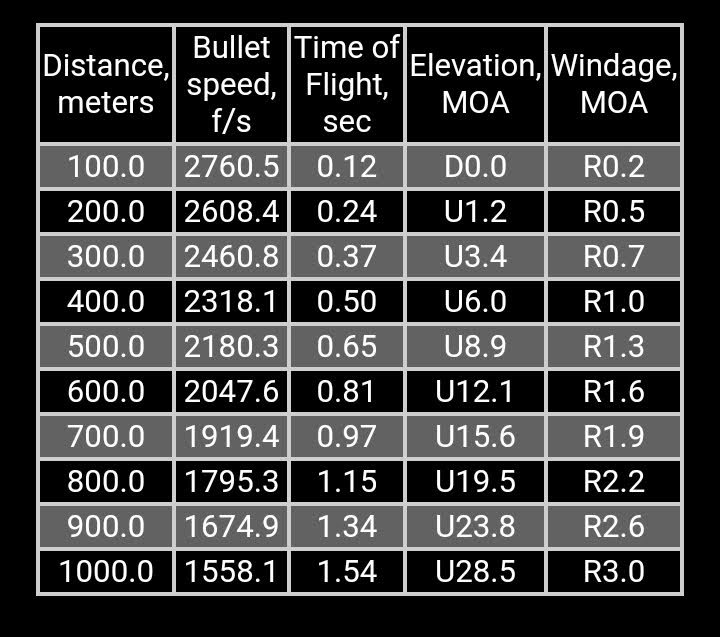
So, that's a very basic introduction to MOA. It can be quite complicated I guess, especially when one isn't a long range shooter and simply reading it in a post like this. I'm probably doing a terrible job explaining it as well, but if there's anyone still reading this post by now I'd be surprised so...It is what it is.
MRAD - Milliradian
This is a common mathematical unit of measure. You probably know that one Radian is just under 57.3 degrees and a milliradian is one thousandth of a Radian right? Mostly milliradian is simply called mils and there are about 6283 of them in a complete circle.
What I like about using MRAD is that it's most usually represented in metres which makes it easier for me as my country uses the metric system. Scopes that use MRAD typically use one-tenth [0.1] adjustment increments so it's easy to see how it will work. 0.10 mils at 100 metres is 1 centimetre, 2 centimetres at 200 metres and at 300 metres is 3 centimetres. Pretty easy stuff here right? It's very straightforward to calculate and adjust for elevation and windage.
Using this in an example at 1000 metres to the target I would need to input 8.3 mils of elevation so 82.9 clicks. You can see that represented below in the table from StrelokPro. The below chart represents an actual rifle I shoot with, a .243 pushing a Hornady 87gr V-Max projectile. Keep in mind it takes no environmental factors into account as I'm sitting at my kitchen table writing this post, not in the field. It's about right though.
See there's no elevation dial required at 100 metres? That's because I have zeroed the rifle at 100 metres so it shoots directly at the centre of the cross hairs.
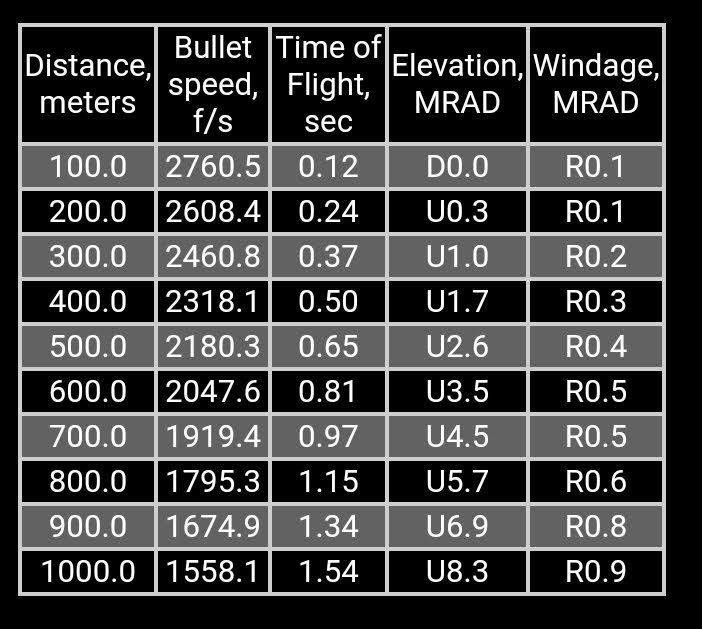
This image below shows exactly what the reticle on the rifle mentioned above looks like and shows the adjustments also. I never use this view but you can see the red dot surrounded by yellow which is where I would need to aim to make that 1000 metre shot above. It is offset to the left as I have called the wind at 5mph from 120 degrees [4pm on a clock face].

So you can see that I'd place the red dot on the target, not the centre of the cross hairs. That would mean I'm actually shooting above the target and to the right of it as the wind will push the projectile to the left and gravity will arc the bullet down into the target. [Bullets don't fly straight you know.] Keep in mind this is at 1000 metres. At 100 metres I'd shoot directly at the centre of the cross hairs as that is where the scope is zeroed.
It's easier
It is widely established that 0.10 mils is 0.9999 centimetres at 100 metres so essentially 1 centimetre. You may question the fact it's not exactly a centimetre, there's a one ten-thousandth variation, and above I mentioned how precise a long range shooter needs to be when calculating shots. That tiny amount is far too small to make a difference though.
MRAD is what they call an International System of Units (SI) method of angular measurement which is based on science. A Radian is defined mathematically as an arc-length to the radius of its circle and so 1/1000th of the radius. This round number scenario makes it far less complex to calculate field firing solutions; The French used it to great effect in the First World War to calculate field firing solutions for their artillery and most militaries nowadays use it as standard.
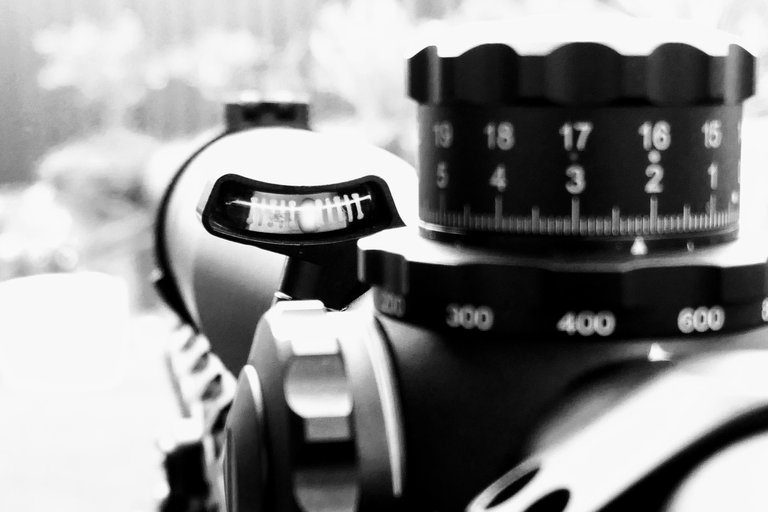
Pros and cons
If a shooter is familiar with the Imperial system MOA can seem more familiar and most ballistic tables are in feet and yards. However the metric values of MRAD calculate far more easily. Further to that with MRAD being extensively used in the military manufacturers are producing far more equipment in support of it. More and better scopes.
I compete in competitive long range events and rarely do I see someone using MOA these days - I once saw a couple shooters paired up randomly as shooter/spotter as part of an event...One was MOA and the other MRAD...Neither knew what the other was talking about which makes it hard for them to operate as a team. Pretty much all the best equipment is MRAD also.
It's difficult to say one is better than the other per se, they're different. If the Imperial system is more familiar to you then MOA might be the way to go. I was born and raised in a metric country so it's MRAD for me. In reality they overlap a little, but that's not for this post as I've written too much already and you probably tuned out 1700 words ago.
Anyone can pull a trigger and send a bullet somewhere...But to be good at it takes effort and understanding; I've been shooting for over thirty years and am still learning. Gaining a good zero on a rifle-system is critical to operating it effectively. Being able to do it at the fun park and hit a few balloons won't help you send rounds out to great distance; More is required. Much more.
Anyway, if you made it to this point and actually read the words well done.
Design and create your ideal life, don't live it by default - Tomorrow isn't promised so be humble and kind
Discord: galenkp#9209
This is not designed as a training document or exhaustive text on the subject and the information contained here should not be relied upon. You are strongly advised to do your own research on the subject matter.
All images are mine.
Fantastic write up. Thanks for sharing
No worries, I appreciate your comment. 😬
Do you not use an anemometer or even a direction meter such as sailors would use and wait for the exact wind speed and direction you've calculated for before making the shot or is this a waste of time over distance as the wind in two places, 1km apart will not be exactly the same in any case?
The other thing about wind is that it brings in a slightly 'random' element that slightly reduces the level of skill involved. It must be fucking annoying beyond words to let off a round and then feel an unexpected gust ruffle your hair!
Having said all that, I'm still more impressed by William Tell. He had no gadgets ;-)
I call the wind without equipment, although learned to do it through using equipment. I feel it on my face, see it with my eyes in grass, trees, dust, sand, on water, clothing, flags etc. I even use the mirage to call speed and direction down range. It takes a lot of time to learn however it is achievable.
When at long range wind can be doing different things, one way at 300m, the other way at 700m and another way at 1200m so I roll through the parallax on the scop, read the signs and then average it out and bracket the target to ensure a hit. It's reasonably advanced stuff, but again over time is totally learnable. Different terrain makes the wind do different things so one needs to be vigilant.
With the random element...Yep, exactly! I've sent rounds at the exact moment the wind has died off and...Miss. This is why I tend to bracket the target to help mitigate that issue. Part of my process for actually taking the shot involves looking down range for signs of gusting wind, or drop offs, and also feeling it on my face as I prepare to squeeze the trigger. It all just takes a lot of practice and training. When something is going to die at the other end of that shot it pays to get it right. There's a lot more going on than just pointing and squeezing the trigger.
I'm not out to impress anyone generally, maybe a girl now and then . 😆
Seriously though I'm not into impressing anyone, but if I was I'd get a cross bow, find a few willing or unwilling volunteers, put an apple on their heads and fucken shoot them. (The apples hopefully). 😂
Thanks for your comment mate, I really appreciate it.
Thanks for filling that in for me!
I really appreciate posts like this mate and yes, I did read every last word.
Take care :-)
No worries, I actually appreciate that you read the post and asked some questions as it sort of validates the time it took to write. 😊
I love it when you try to tell everyone you're a knucklehead and then you write stuff like this XP
Haha, yeah sometimes I have moments of mathematical/geometrical brilliance.
Other times I'm a knucklehead. 😏
NERD...
A really bad ass nerd, that I want in my survival camp during the apocalypse...
And this...
Dude, I'd let you shoot an apple off the top of my head any day!
Haaaaa..!
Challenge Accepted...
3 strikes..?
Hit the apple, not the melon it's sitting on.
Great writeup. I switched from MOA scopes to MRAD scopes a few years ago and would never go back. It took 3 times shooting and adjusting to get used to it, then I liked it so much I replaced nearly all my scopes. I'm still stuck in using yards for my distance estimates though, too many years experience there and guessing that will be harder to adjust my brain to meters.
Yeah I'm not surprised, it's such an easy system. On the yards thing...It's interesting as I use metres for distance but when I call wind I use mph not kph. Is that weird? It's how I learned, (mph) and whilst I know the conversion I never do it. I'll call it then input that to StrelokPro in mph and it does the calculation as usual. It's set with a mix of metric and imperial measurements. A bit weird, but it works.
MOA is good enough for my skill level so far. One day, I hope to build skills to the point where a true precision rifle and the need to consider MRAD adjustments is relevant to my life, though.
If it works there's no need to change. MOA is a good system that gets the job done.